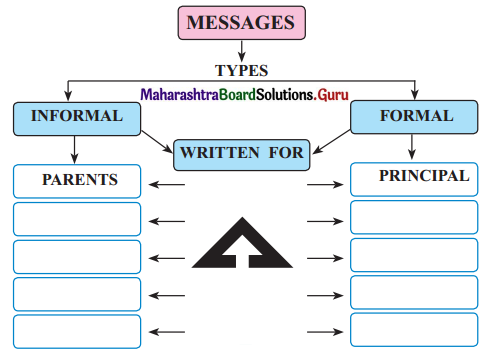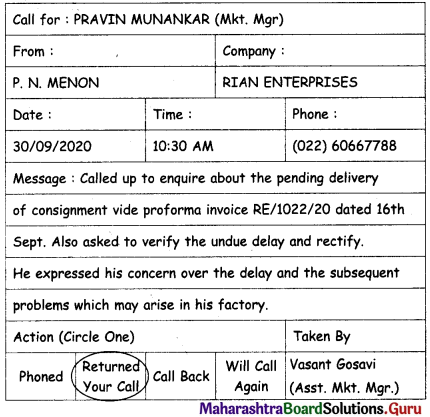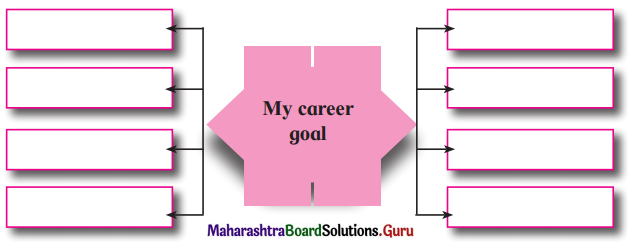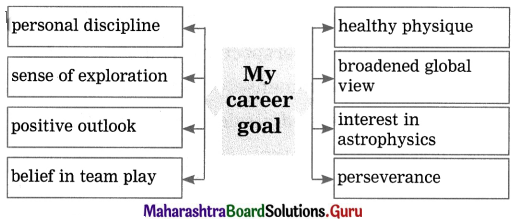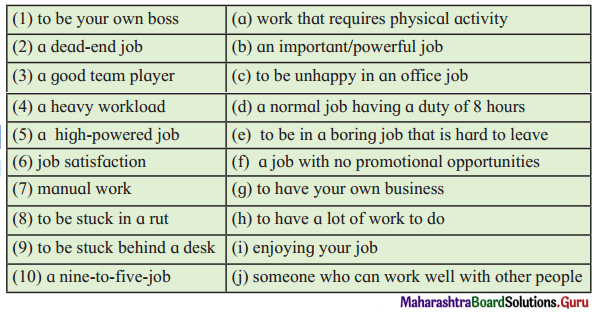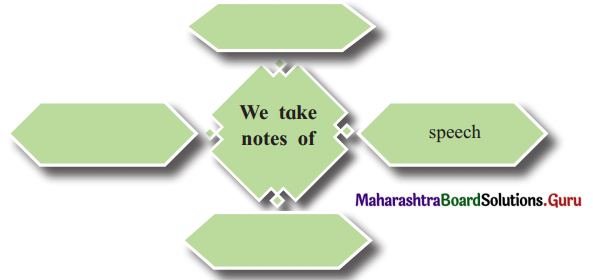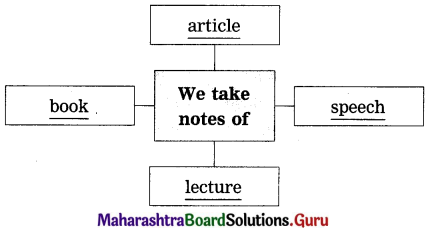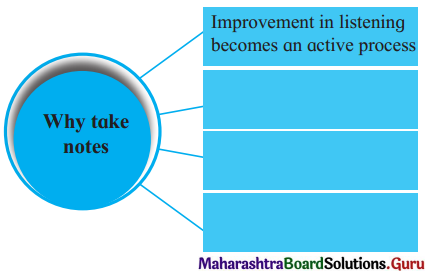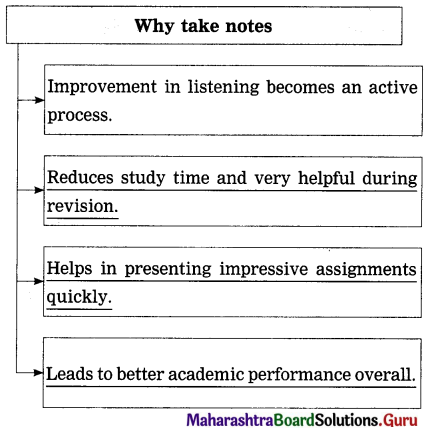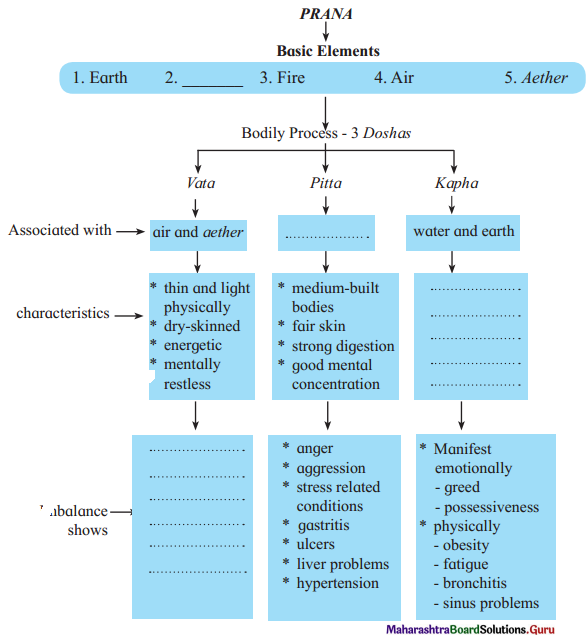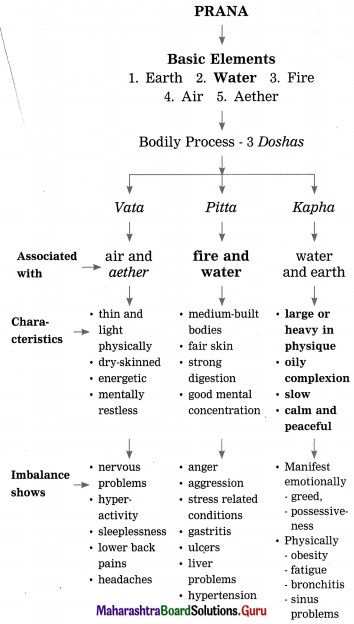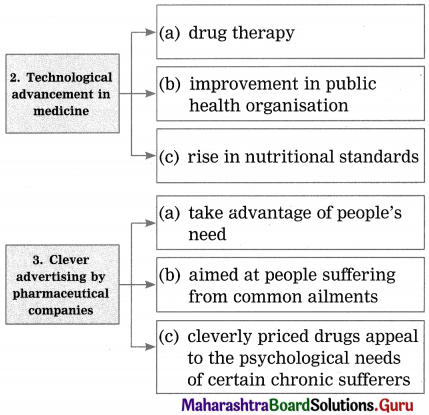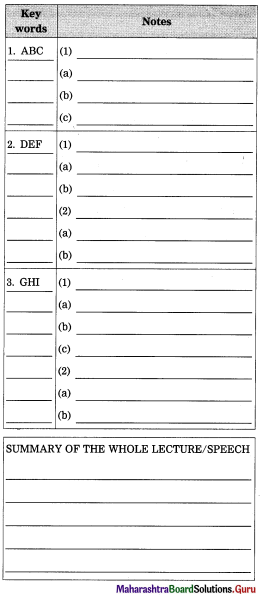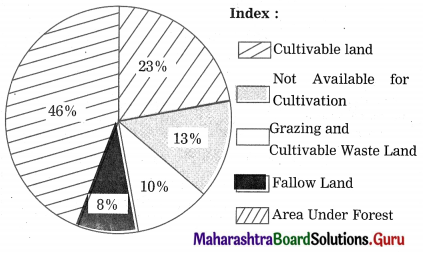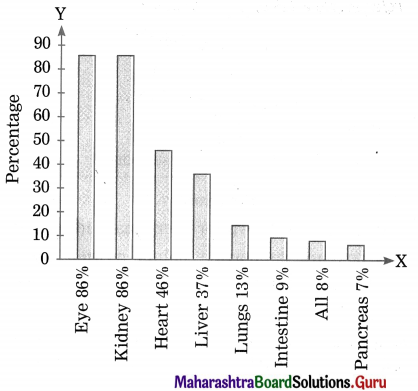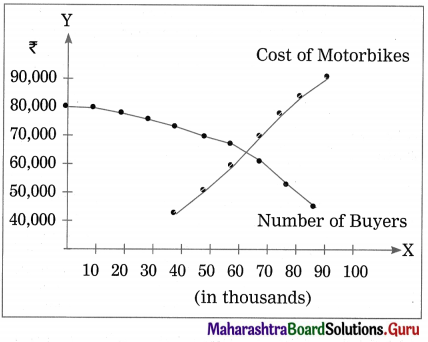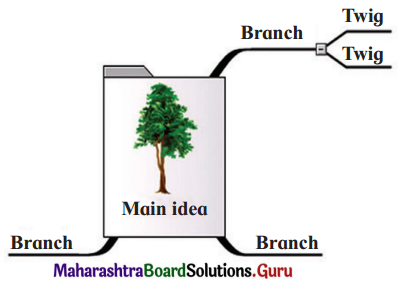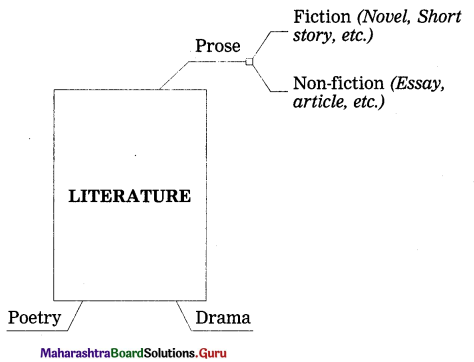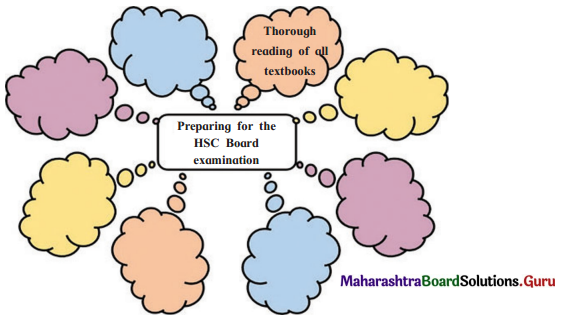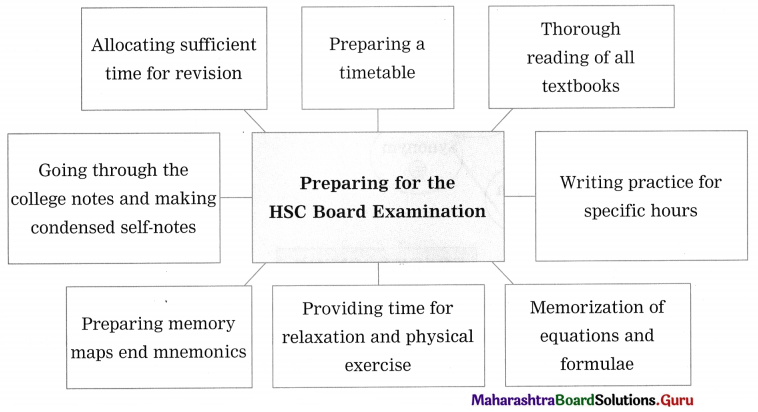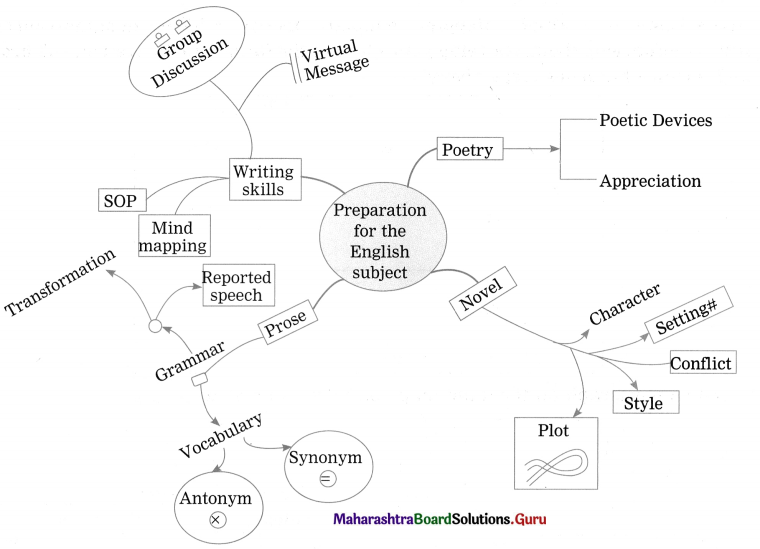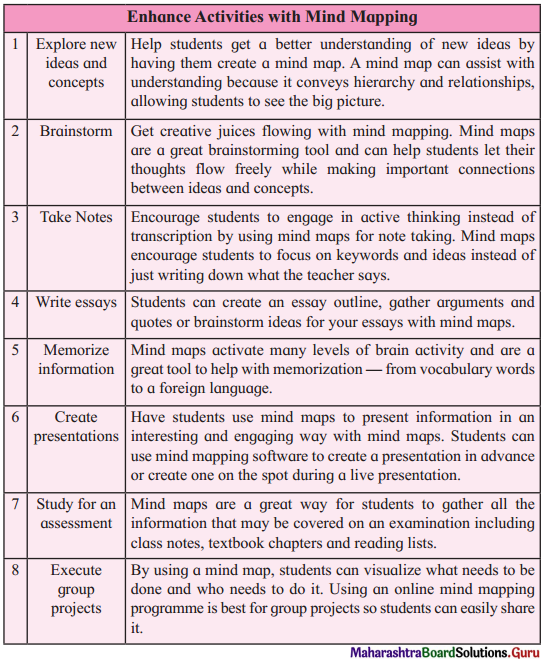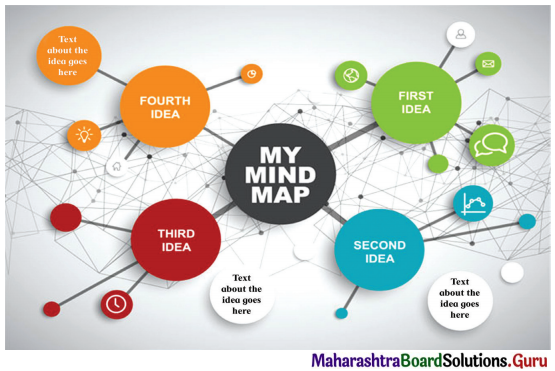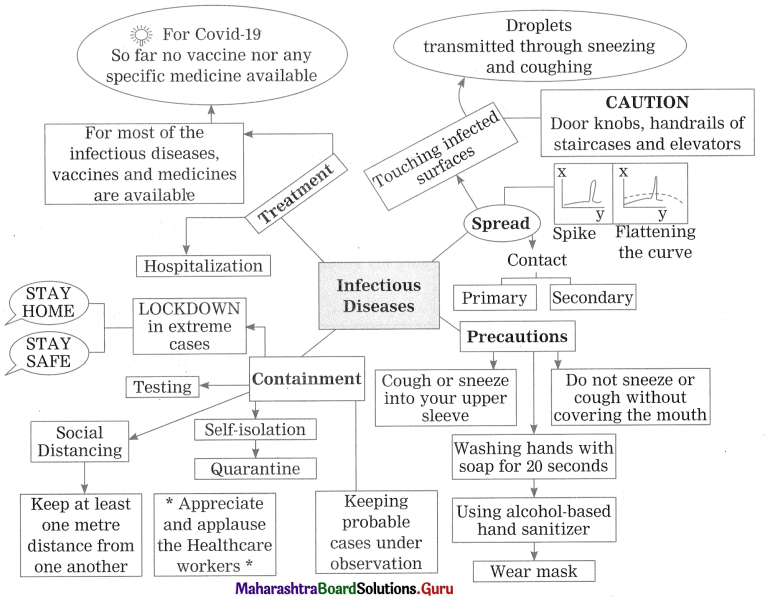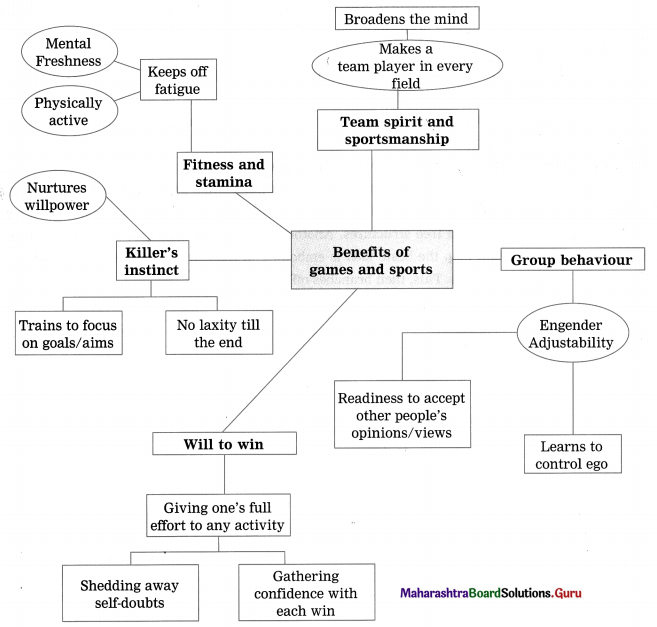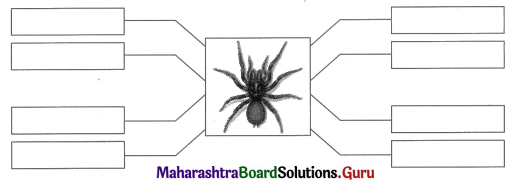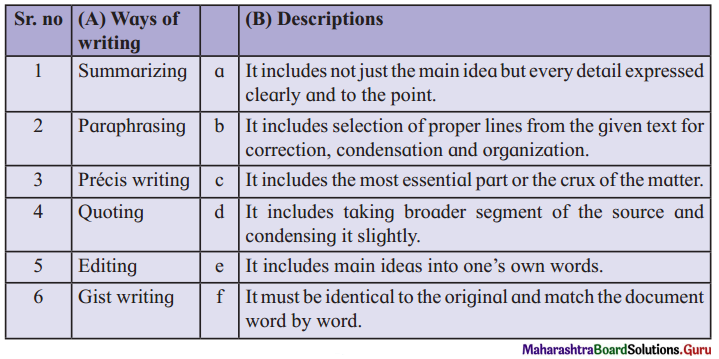Balbharti Yuvakbharati English 12th Digest Chapter 3.6 Group Discussion Notes, Textbook Exercise Important Questions and Answers.
Maharashtra State Board Class 12 English Yuvakbharati Solutions Chapter 3.6 Group Discussion
12th English Digest Chapter 3.6 Group Discussion Textbook Questions and Answers
You must have discussed many things with your friends, classmates in a group. It might be about going on a picnic or selecting a gift for your teacher:
Question (i)
What do you think are the benefits of a group discussion?
Answer:
(a) A Group Discussion allows the participants to share their views and opinions.
(b) It allows each participant to analyse the topic or case.
(c) A Group Discussion allows the participants to reach a general consensus.

Question (ii)
Do you think some people are right and some are wrong in a group discussion? Why?
Answer:
Yes, I do think so. Generally, we hold a view on a topic or a situation. This view is either strengthened or weakened by the ongoing arguments in a Group Discussion. Due to j confirmation bias, we tend to think that the participants who strengthen our views j are right. Similarly, we think of those who go against our views are wrong. (The ideal situation is that we keep an open mind and assess each argument on its own merit but this is easier said than done.)
Question (iii)
People have different views and opinions because:

Answer:


Question (iv)
Complete the web highlighting the uses of ‘Group Discussion’. One is done for you.
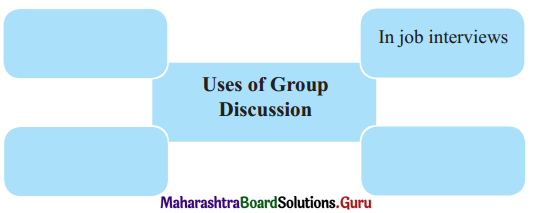
Answer:
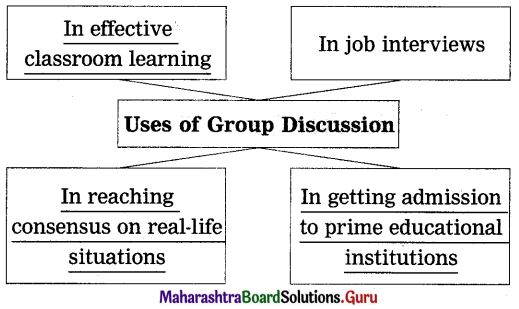
(A1)
Question 1.
Rama, Asif, Rachana and Aarav are participating in a group discussion. The evaluator has given them a topic. ‘Teenagers are more inclined towards junk food nowadays.’ Write suitable dialogues for each participant giving his/her opinion on the topic.
Evaluator: You’ve all been given a few minutes to think on your topic for today’s group discussion, which is ‘Teenagers are more inclined towards junk food.’ You may now begin the discussion. Who would like to start?
Rama: ………………………………………………. .
Asif: ………………………………………………….. .
Aarav: ……………………………………………….. .
Rachana: ……………………………………………. .
Evaluator: Please conclude.
Aarav: ………………………………………………… .
Answer:
Rama: I think I will. In my opinion it is very true. Junk food leads to obesity and we find more obese teenagers around nowadays.
Asif: I am afraid I can’t agree with that statement. Most of the teenagers in our college look quite fit and active.
Aarav: I think we must see the issue in a wider perspective. The inclination towards junk food among teenagers is a worldwide phenomenon. One can’t jump to a conclusion by just looking around and citing a few examples in our college.
Rachana: It seems to me that Rama made a valid point. Teenagers world over are inclined towards junk food and it poses a great threat. I suggest the teenagers change their food habit and resort more to healthy snacks. Our tradition offers a wide variety of such snacks.
Evaluator: Please conclude.
Aarav: We can conclude by saying that our teenagers are inclined to junk food. They must change their food habit. It is high time they switched to healthy snacks. We need healthy citizens to take our country forward.

(A2)
Question 1.
Read the following statements, if you agree say ‘Yes’ and if you don’t agree, say ‘No’. State the reason for your opinion.
Answer:
| Statement |
Yes/No |
Reason |
| 1. It is not possible to guess the topic for group discussion. Then there is no need to prepare. |
No |
Topics for Group Discussion are mainly chosen from things happening around us. So, we must keep our minds open and receptive to the happenings around us. The knowledge thus received and the opinions and views we form about each such topic will prove to be our preparation for the group discussion. |
| 2. Always have discussion with your family and friends on different topics. |
Yes |
We may be wrong in our opinions/views. Constant discussions with family and friends help us form the right sort of views/opinions. |
| 3. You must aim to get noticed by the evaluators. |
No |
We must get noticed mainly by the force of our arguments and our active involvement in the discussion. Evaluators are experienced to assess our analytical power and assertive approach. Any deliberate effort to outshine other participants will do more harm than good. |
| 4. Forget the evaluator and look at the participants during the discussion. |
Yes |
The evaluator is a passive observer. Discussion happens only among the participants. Glancing at the evaluator often could be treated as a sign of your distracted mind. |
| 5. You should raise your voice to be heard by everyone and speak for a long time to show your knowledge. |
No |
Our voice should neither be too high nor be too low. Raising one’s voice much more than necessary will create the impression of a rabble- rouser. Our grasp of the topic must come out naturally through the novelty of our arguments. Brevity and concision must be the watchwords. A long and verbose argument will surely produce a negative impact. |
| 6. You should always take the opportunity to begin the argument. |
No |
Though initiating a discussion shows our leadership qualities, an overzealous approach may at times go against us. |
| 7. Take a strong position/view and defend it till the end. |
No |
If another participant contradicts our view with sound reasoning, we must concede to it. Taking a strong position beforehand may restrict us from considering other point of views. |
| 8. Do not keep waiting for your turn to speak. You have to be alert and quick. |
Yes |
We must be alert and quick. We must sieze the opportunity to speak. Being too passive may even deny us a chance to present our views. |
| 9. Listening to others also plays an important role in a group discussion. |
Yes |
Listening to others is a crucial element in group discussion. It helps,us to formulate new perspectives and modify our viewpoints in the course of the discussion. |
| 10. You must interrupt a person if you do not agree to his opinion. |
No |
Everyone has the right to hold individual opinions. Moreover, interruption denies the person the opportunity to complete his views. We can take up the counter-argument as soon as he finishes his views. |
| 11. Show your leadership skills being assertive not aggressive. |
Yes |
Assertiveness is a positive trait. It is a sign of leadership quality. We can be assertive by the force of our arguments and the conviction we have in our views. Aggression, on the other hand, will only expose our untamed personalities. |
| 12. Participating in a group discussion also means helping everyone to reach a consensus in spite of difference of opinion. |
Yes |
Assertiveness is a positive trait. It is a sign of leadership quality. We can be assertive by the force of our arguments and the conviction we have in our views. Aggression, on the other hand, will only expose our untamed personalities. |
Reason: Group discussion helps us realize that there are other possible views and opinions. A receptive and accommodative mind is a prerequisite for anyone who participate in a group discussion. Moreover, the candidate must be able to feel the pulse of the discussion. This, in turn, will help to reach a consensus.

(A3)
Question (i)
Group discussion helps to unravel the following personality traits in a person.

Answer:
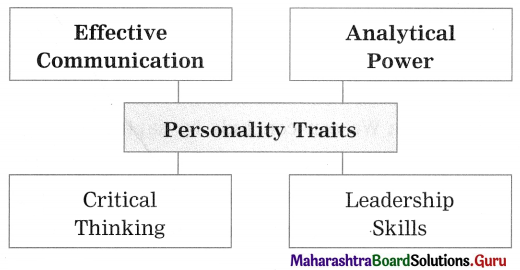
Question (ii)
Match the following:
| Discuss |
Give special importance or value to something in speaking or writing. |
| Argue |
Say something again, a number of times. |
| Deliberate |
Express opposite views in a heated or angry way. |
| Reiterate |
Engage in long and careful consideration. |
| Emphasize |
To talk about a subject with someone and tell each other your ideas and opinions. |
Answer:
| Discuss |
To talk about a subject with someone and tell each other your ideas and opinions. |
| Argue |
Express opposite views in a heated or angry way. |
| Deliberate |
Engage in long and careful consideration. |
| Reiterate |
Say something again, a number of times. |
| Emphasize |
Give special importance or value to something in speaking or writing. |

(A4)
Question (i)
Write the following sentences in reported/indirect speech:
(a) He said, “If you find my answers satisfactory, will you give me five rupees?”
(b) The astrologer said, “You were left for dead. Am I right?”
(c) “I should have been dead if some passerby had not chanced to peep into the well,” exclaimed Guru Nayak.
(d) He told her, “Do you know a great load is gone from me today.”
Answer:
(a) He asked me whether I would give him five rupees if I found his answers satisfactory.
(b) The astrologer asked whether he was right in saying that I had been left for dead.
(c) Guru Nayak exclaimed that he would have been dead unless some passerby had chanced to peep into the well.
(d) He asked her whether she knew that a great load was gone from him that day.
Question (ii)
Read a part of a conversation between Neha and Nidhi.
Answer:
Neha: Where are you going, Nidhi?
Nidhi: I am going for my music lessons.
The above conversation is written in exact words spoken. If this conversation was to be reported by a third person then it would be written as:
Neha asked Nidhi where she was going. Nidhi replied that she was going for her music lessons. Notice the changes in the reported sentence.
Note the changes in pronouns, tenses, reporting and reported verbs and other changes.
Answer:
1. Table showing tense change:
Simple Present → Simple Past
Present Continuous → Past Continuous
Simple Past → Past Perfect
Past Continuous → Past Perfect Continuous
Simple Future → Conditional
2. Table showing change in Place and Time
- here – there
- now – then
- today – that day
- tomorrow – the next day
- yesterday – the day before
- next week – the following week
- last night- the previous night
3. Table showing the changes in Pronoun.
| I |
he/she |
our |
their |
| me |
him/her |
ours |
theirs |
| my |
his/her |
you (subject) |
I/he/she/we/they |
| mine |
his/hers |
you (object) |
me/his/her/us/them |
| we |
they |
your |
my/his/her/our/their |
| us |
them |
yours |
mine/his/hers/theirs |

Question (iii)
Now find sentences from the text in the direct speech and convert them into the reported speech.
(Students may attempt this on their own.)
Read the following sentences given in the indirect speech and convert them into the direct speech.
(a) Shirish said that he would not be able to solve the problem.
(b) Lata told me to give her a glass of water.
(c) Ananya exclaimed with joy that she had received the Ph.D. degree.
(d) Shilpa asked us if there was any other Rian document to be typed.
(e) Swati said that she would not get the money.
Answer:
(a) Shirish said, “I will not be able to solve the problem.”
(b) Lata said, “Give me a glass of water.”
(c) Ananya said, “Hurrah! I have received the Ph.D. degree.”
(d) Shilpa said, “Is there any other document to be typed?”
(e) Swati said, “I will not get the money.”
(A5)
Question (i)
An economically deprived girl student in your class who has received admission in a reputed college abroad needs monetary help to pursue further studies there. Have a group discussion amongst your friends to seek solutions to help her. Write four/five views in the form of dialogues.
Answer:
- Rian: Well, folks! we need to do something urgently in Tejaswini’s case. Money shouldn’t come in her way to pursue a course abroad. My parents offered 50,000/- right away!
- Eugine: I managed to get a loan of rupees one lakh from my parents. I should take up some part-time job and repay it within three years. I hope I will be able to do it. Anyway, I am quite happy to be of some help to our dear friend.
- Kanika: Only way before me was to ask for an advance from my music troupe. We don’t get much programmes of late. Still they agreed to pay me 75,000. Will that be okay?
- Tabu: We thought you would raise a hefty sum, being ‘a great singer’ and all. Okay, jokes apart, I will present my case. My brother offered a donation of rupees two lakh right away. No conditions! No strings attached!!
- Rian: Okay, folks! Now we have pooled 4.25 lakhs.
That will bankroll Tejaswini’s fee, travel, initial expenses, etc, etc. She can very well take up a summer job and the like to meet her further expenses. Let’s now congratulate ourselves for being such thick friends!

Question (ii)
There is an inter-school cricket match and your school is losing. As you are the captain, have a group discussion with your teammates in the tea-break about the strategy to be followed to save your school from losing the match. Give at least four /five suggestions.
Answer:
- Captain: See, we must break this partnership anyhow. Both the batsmen appear very much settled and they are hitting all over the place.
- Spinner: The pitch doesn’t support many turns. I suggest we bring back the fast bowlers.
- Captain: You have a point there. What we need most now is a wicket. Right now. Otherwise, the game is as good as lost.
- Fast bowler (1): I agree that we resume pace bowling. But remember: it’s a gamble. I think I will need a slip-in position. I will attack, outside the off-stump. Hope I get the right line.
- Captain: What do you think, Sonu?
- Sonu (Fast bowler) (2): Okay then. I will take up from the pavilion end. Think the wind is in favour.
- Captain: Attempt yorkers.
- Sonu: Sure. I suggest you keep a deep third man.
- Captain: Done. Now, guys-no sloppy fielding-no dropped catches. And nothing short of a win. (All go into a huddle.)
Question (iii)
Form four groups in your class and have a group discussion on the following topics.
(a) Role of ICT in education
(b) Clean India
Yuvakbharati English 12th Digest Chapter 3.6 Group Discussion Additional Important Questions and Answers
Other writing skills:
Dos and Don’ts associated with ‘Expansion of Ideas’:
| Dos |
Don’ts |
| 1. Begin impressively. |
1. Do not go off-track. |
| 2. Have unity and clarity of thoughts. |
2. Do not forget to give the symbolic meaning of the statement. |
| 3. Use discourse markers. |
3. Do not forget to include the topic sentence. |
| 4. Use proverbs with similar meanings. |
4. Do not omit a proper conclusion. |
Expand the idea inherent in the following:
Question 1.
Charity begins at home Ans. Charity is the noble deed of giving money, food or other help to people who are in need of these things. The given proverb is a warning to those who seek fame in the name of charity. The proverb reminds us that we must first help the needy people around us – our family and friends. Any deed of charity that forgets this principle goes against the spirit of this high ideal.
Our deeds of charity must begin from the centre and then radiate to the periphery. Or else, it would prove to be a selfish pursuit of chasing fame or other favour. We must first open our eyes to the miseries around us. We must first cater to the needs of these people. Then we can spread our work of charity farther afield.
We see that many people treat their family members and servants very shabbily. But when it comes to a photo opportunity to pose as a philanthropist, they jump at it. This is sheer hypocrisy and the saying serves as an eye opener to these hypocrites.

Question 2.
Make hay while the sun shines
Answer:
Hay making, that is the process of cutting and drying grass, must be done while the sun shines. Rain would spoil everything and the farmer knows it well. In other words, we should make the best use of opportunities and favourable conditions while they last.
When life presents opportunities, we must seize them and not let them go. Everyone in their lifetime gets a chance to move ahead in life. If we miss that opportunity, it may never come our way again. We will live all our life to regret the missed chance. In short, we should seize the chance while it exists. We must always be alert to notice the opportune moment. Grab it and move further in life. To put it in another way : “We must strike while the iron is hot”.
Question 3.
Prevention is better than cure.
Answer:
The proverb stresses the need for foresight and precaution in dealing with any possible eventuality in life. We often ignore the signs of trouble and when the trouble finally, occurs, we regret our neglect.
We must make it a practice to guard ourselves against diseases by taking adequate preventive measures. This will save us the trouble of undergoing costly treatments. Strangely, certain epidemics offer no cure or vaccine for a long time, then prevention becomes the only option before us. Wearing of masks, keeping social distance and maintaining hand-hygiene are the only ways to save us from such a threatening situation.
Metaphorically, the idea can be extended to fields other than disease and medicine. Proper maintenance of machines, roads and bridges can prevent their deterioration and thus forestall disaster. At the political and economical level too, many problems that we face today would not have existed had the authorities acted promptly, firmly and boldly at the very start.
Examples for Practice:
- Unity is Strength,
- Books – Our best friends,
- Honesty is the Best Policy
- Perseverance is the Key to Success
- Pollution: Earth’s enemy number one.
Formal Letters:
General Format for a Formal Letter:
- Sender’s Address
- Pin Code
- Date
- Name and address of the addressee
- Subject (a phrase about the general content of the letter)
- Reference (referring to a letter previously received/advertisement etc.)
- Salutation (Dear Sir/Madam or simply Sir/ Madam)
- Body of the letter (in 3 or 4 paragraphs)
- Subscription (Complimentary Close like Yours faithfully, Yours truly, etc.)
- The name given in the Activity Sheet/XYZ

Write the letters as instructed:
Question 1.
Write a letter to the editor of a newspaper drawing attention to the increasing noise pollution in your area.
Answer:
3 A, Ravikiran,
Chikuwadi,
Borivali (West),
Mumbai – 400 092.
1st September, 2020
The Editor,
The Indian Express,
Nariman Point,
Mumbai – 400 021.
Sir,
I wish to draw the attention of the authorities to the terrible noise pollution in our neighbourhood. There is deafening noise created by heavy traffic on the narrow roads of our locality throughout the day and night. The drivers honk continuously, and the vehicles emit poisonous fumes. The hawkers who sell their goods on the roads and footpaths shout at the top of their voices.
All this is literally making the people sick. With the approaching festival season, the beat of drums and the loud music accompanying it are bound to make life all the more unbearable for all of us who reside here.
I hope the authorities concerned wake up in time to the hazards of noise pollution and take prompt action to stop this menace.
Yours truly,
ABC
Question 2.
You want to visit a sugar factory to know more about the sugar production process. Write a letter to the Manager of the sugar factory near your college seeking permission. Give details about the intended visit.
Answer:
Ideal College,
Vidyapeeth Marg,
Beed – 431 122.
5th February 2020
The Manager,
Sakhar Factory Ltd.,
Beed – 431 122.
Sub: Request to visit your factory.
Dear Sir,
As part of our science project, 10 students of Std. XII (Ideal College) would like to visit your factory during the latter half of this month. We will be accompanied by our Chemistry Professor, Dr Ahirwal. It is our desire to have first hand information about the production of sugar. We believe that a visit to the factory will give us more valuable information than we can ever get out of textbooks.
Do let us know what would be the most suitable day and time for our visit. Since we now have study leave, any day and any time will be suitable for us. Also let us know if there are any special rules or conditions we need to follow during the visit. We do hope that you will not say no to our request.
Yours faithfully,
XYZ

Question 3.
Write a letter to a celebrity who supports a meaningful and innovative campaign and thus has become your idol.
Answer:
7, Vicky Apartments,
J.T. Road,
Nashik – 422 001.
17th September, 2020
Ms. Nandita Das,
Actor and Activist.
Dear Ms. Das,
Your support to the campaign ‘Black is Beautiful’ made a real impact on me. Honestly, I now look upon you as my guide, mentor, pathfinder and idol.
I have always found the discrimination based on colour really disgusting. It is nothing short of racial bias. I wish to join this campaign. I want to fight against the revolting obsession with the skin colour.
As you are a person who lived and proved this bias wrong, I take courage from you. You are a pathfinder and idol for today’s youth. I wish all those who are involved in the campaign the very best.
Yours sincerely,
RST
Question 4.
The New Arts, Science and Commerce College, Karad- 415 101, needs a librarian, They have advertised in the Indian Express, dated 17th October 2020. Write a letter of application to the Principal, with the help of the CV given below:
Curriculum Vitae (cv)
Name: Ms Deepali Rane
Address: A-303, Munir Apartments, Valkumbh, Karad – 415 110.
Email: dr3636@gmail.com
Nationality: Indian
Date of Birth: 16-5-1990
Qualifications: B.Com., B. Lib. Sc.
Experience: Working as an Associate Librarian at the Karad Public Library.
Languages known: Marathi, English, Hindi
Interests: Reading, painting, music
Answer:
A-303, Munir Apartments,
Valkumbh,
Karad- 415 110.
17th October 2020
The Principal,
The New Arts, Science and Commerce College,
Karad – 415 101.
Sub: Application for the post of Librarian.
Ref: Your advertisement in the ‘Indian Express’, dated 17 October 2020.
Sir/Madam,
This is with reference to your advertisement in the ‘Indian Express’, dated 17 October 2020 for the post of librarian in your college.
I am a qualified librarian. I passed my B.Com. in 2011. I also passed the degree in library science in 2013, from Pune University, with First Class. Since then, I have been working at the Karad Public Library as an Associate Librarian. I can speak English, Hindi and Marathi fluently.
I am applying for the job in your renowned college as I feel that I now have sufficient experience to take up independently the job of a librarian. I get along well with the younger generation, and I can assure you that I will do my best to give you satisfaction, should you appoint me for the post. I enclose photocopies of the necessary certificates.
Thanking you,
Yours faithfully,
Deepali Rane
Enel. : Photocopies of B.Com, B. Lib. Sc. Certificates

Report Writing:
Write the reports as instructed:
Question 1.
During a global pandemic, a nationwide lockdown was announced. Write a newspaper report on this with the help of the following points :
- Declaration of the lockdown
- All movements stopped
- Essential services allowed
- Guidelines for safety laid down
Answer:
Biggest Lockdown Ever
Staff Reporter
New Delhi, March 25: Nation went into a lockdown at the stroke of midnight amidst the ongoing threat of COVID-19 pandemic. Though the scare of the pandemic has been in the air for some time, the lockdown came as a bolt from the blue to citizens all over.
The Prime Minister declared the step of lockdown in a live telecast on TV at 8:00 o’clock last night. The PM in his speech appealed to the citizens to maintain the lockdown rules fully and effectively. “There is no better option before us than going into this strict but painful measure,” he told the country during the telecast.
Flights, domestic as well as international, are now grounded. Railways suspended all services. Public transport came to a halt. Only essential services are allowed and the police are on the streets to ensure that everyone complies with the lockdown measures. Detailed guidelines for the lockdown have been laid down and citizens are advised to venture out only for emergencies. The message of social distancing and hand-hygiene are put across through various media.
“Stay Home and Stay Safe” is the new mantra. As normal life has been hit unlike anything that happened in the past, the citizens are grappling with the new norms. “We must sacrifice our liberty for a greater common good,” a senior citizen told this reporter.
Question 2.
Write a report of Republic Day Celebrations in your college.
Answer:
Republic Day at Model College Malegaon, January 28: This year, Republic Day was celebrated with great fanfare on the campus. It was a special occasion because Narendra Jain of the NCC was to be felicitated for winning the target-shooting gold medal by the Police Academy. The National Flag was unfurled at 7-30 a.m. by the Chairman of the College Management Trust.
The National Anthem was played by the college band while everyone stood respectfully to attention. Meera Pandit of Std. XII recited a poem composed by her, ‘Majha Desh Mahaan’. This was well appreciated by one and all. The Chief Guest spoke to us about our duties as citizens of the Republic of India. Then Narendra Jain was given the award by Senior Inspector Kale of the Police Academy. This was a solemn ceremony. Sweets were distributed and the gathering then dispersed.

Question 3.
Read the following headline of a news item “Cold Wave Sweeps North India”. Write a suitable dateline, lead paragraph and conclusion. Use a byline as well.
Answer:
Cold Wave Sweeps North India By A Special Correspondent Delhi, December 12 : Winter continued to send shivers across northern India, claiming another life in Uttar Pradesh. Delhi recorded the coldest day in the past fifty years on Monday.
A four-month-old boy died in Kanpur. The winter chill also swept through Punjab, x Haryana, Rajasthan, and Himachal Pradesh and minimum temperatures hovered between minus and plus five. The mercury dipped to a record low in many northern cities. In New Delhi, the air traffic has been severely hit by the fog.
Question 4.
Read the following headline of a news item “Milk for Millions” scheme inaugurated. Write a suitable dateline, lead paragraph and conclusion. Add a byline.
Answer:
‘Milk for Millions’ Scheme Inaugurated
By Sonali Mazumdar
New Delhi, August 29: Inaugurating the ‘Milk for Millions’ scheme of the National Dairy Development Board (NDDB) here, the Prime Minister called for a second white revolution to provide milk to the millions of undernourished infants of the country. “We must ensure at all costs that our infants get the basic nourishment, which is their right by birth,” he declared amidst loud applause.
The NDDB chairman said the projected 300 million output for 2020-21 would suffice to support the scheme. “A detailed plan with Panchayat-level participation has been already chalked out for the execution of the scheme,” he added.
Question 5.
Mumbai School Sports Association’s (MSSA) under-14 interschool football championship final was held on 17th November. Write a newspaper report on this with the help of following points :
- Don Bosco School vs Gokuldham School
- Don Bosco won by 3-1
- Goals scored after the half time
- Venue: Brabourne stadium
- Shield awarded
Answer:
Don Bosco Bags Mssa Shield
By Sports Reporter
MUMBAI, November 18: In the Mumbai School Sports Association’s (MSSA) Under-14 interschool football championship final, Don Bosco beat Gokuldham 3-1 at Brabourne here today.
The clash of the old rivals was a sheer delight to the crowd. Till half time, it was anybody’s game. Expectedly, in the second half, Don Bosco went on the offensive hook, line and sinker. Their ace striker Vipul Shetty shot two marvellous goals within the span of six minutes. Later, Mukul Vanik’s header off a corner kick came as the saving grace for Gokuldham. Don Bosco’s captain Melvin D’sa received the shield amidst loud cheering.

Question 6.
An auto driver returns a bag of cash to a passenger who had forgotten the bag in the auto. Write a newspaper report on this with the help of following points :
- Notices the bag after dropping the passenger
- Began the search for the owner
- Ultimately traced the passenger
- Refuses reward
- Honesty is the best policy.
Answer:
Auto Driver Shows The Way – By Aarohi Bokil
PUNE, March 12: Setting yet another example to prove ‘honesty is the best policy’, an auto driver here returned a bag containing two lakhs to its owner.
“I was queuing at the petrol pump after dropping my last passenger when I noticed a leather bag on the back seat. Opening it I found wads of notes; and then my hunt for the owner began,” Abdul Latif – the auto driver – said.
It took Latif two hours and two hundred rupees worth of fuel to trace the owner. “It is nothing short of a miracle that he traced me following such vague leads,” Hiten Vora – the bag’s owner- said with a voice breaking with emotion. Abdul Latif, however, refused to take any reward. When asked about the loss he incurred in the process, the youngster dismissed the issue with a hearty laugh.
Speech Writing
Draft the following speeches as instructed:
Question 1.
Prepare a short speech to be delivered by you in class on the occasion of the send off for students of Std. XII.
Answer:
A Hearty Farewell
Honourable Principal, Respected Professors and dear friends,
Today is an important day for us because it is the day we take leave of you in order to study for the coming HSC examinations. We hope that all of us will pass the examination with resounding success. Some of us may continue with higher education, some of us may seek employment hereafter. But we shall never forget these two years that we spent on this campus. These were years not only of great fun and freedom, but also of successful learning.
We got our first lessons in democracy here. We learnt to live in harmony with all kinds of people. Our professors were patient with us and were always there to clear our doubts. We are grateful to them. We are also grateful to all of you who made these years such a rich experience for us. A heartfelt thanks to you once again, and may God bless our efforts in the coming examinations.
Thank you.

Question 2.
Prepare a short speech to be delivered by you in class on the occasion of the Independence Day.
Answer:
India of My Dreams
Respected Sir/Madam and dear friends,
This is a very special and important day for us. On this day we remember those who fought for our freedom. On this day our National Flag flies atop all important buildings and institutions. I believe that Independence Day is a day when we need to pledge ourselves to the nation anew. It is a day when we need to make fresh commitments to all the ideals of our Constitution; ideals such as freedom, justice, equality and brotherhood. It is a day when we need to put to test whether we truly follow these ideals.
Let us carry forward the torch of freedom. Let us in fact be soldiers who will fight against the evils that this nation now faces; evils such as terrorism, corruption, inequality and superstition. Only when these evils are overcome, will our nation be truly free.
Jai Hind!
Question 3.
Write a speech on ‘Democracy’.
Answer:
Ideal Democracy
Honourable Judges, Respected Teachers and dear friends,
Unfortunately, democracy in India today does not work the way it should. It is limited to the day when the masses go to the polling booths and cast their votes. Then they return to their routine lives.
Most people do not actively participate in serious social issues. They do not react to the injustice happening around. Many among us do not bother to raise our voice against the corrupt practices going on around us. Casting our votes once in five years or so is not the sole idea of being a responsible citizen. A citizen should be always vigilant. Likewise, we also need a responsible media to expose those who are corrupt. Further, the people’s representatives should realize that they are accountable to the voters. If all these things work together then only can we reap the real fruits of democracy.
Thank you!

Dialogue Writing:
Write the dialogues as instructed:
Question 1.
You wish to open a postal savings account in the post office in your locality. Write the conversation between you and the Postmaster in the form of a dialogue.
Answer:
- Myself: Good morning sir. I wish to open a I postal savings account. How do I go about it?
- Postmaster: Just fill this form giving proper details about your name and address and sign on the dotted line there at the bottom.
- Myself: What is the minimum amount that I can put in?
- Postmaster: Oh, you can put in any amount you want. How much do you want to deposit right now?
- Myself: I would like to open the account with 500.
- Postmaster: Then hand over the money to me and I will give you a receipt for it.
- Myself: Here is the form and the money. Postmaster : Here is your receipt. Now you have a postal savings account. You can collect your passbook after half an hour.
- Myself: Thank you sir.
- Postmaster: You’re welcome.
Question 2.
Write a conversation between you and your mother about ‘domestic duties’:
Answer:
- Myself: Mother, do I have to do the dishes every day?
- Mother: Well, dear, you’ve got to learn sometime. You can never tell when the need may arise.
- Myself: But I have so much to study. And I have projects to complete.
- Mother: I understand. But this work has also to be done.
- Myself: Can’t the servant do it?
- Mother: Oh, she will be coming late today and the dishes are all cluttered up. In the future it will be very difficult to get a domestic help. Then you will thank me for training you.
- Myself: Mother, I plan to get a good job and earn a lot of money. I will employ a housemaid permanently in my house to look after everything, including looking after the children.
- Mother: You can never be so sure about the future. So just get down to the dishes, and don’t argue.
- Myself: Ok mother, if you say so.
Question 3.
You are in Std. XII in your college. On the first day of the new academic year you meet a student of Std. XI. Write a conversation you have with the ‘fresher’ :
Answer:
- Myself: Hello. You’re new, aren’t you? What’s your name?
- Fresher: Hello, I’m Nitin.
- Myself: Which school are you from?
- Fresher: I’m from Ideal School.
- Myself: I guess you’ve taken Commerce. Right?
- Fresher: Yes.
- Myself: I’m in Commerce too. Have you found your class? You seem nervous.
- Fresher: Yah. It’s the first day. And they say that the seniors rag the freshers.
- Myself: Oh, nothing. Just a little teasing, that’s all. You don’t have to be scared. It’s only to make you feel at home.
- Fresher: Will you be there?
- Myself: Yes, I’ll be there. Don’t worry. My name is Ketan. I’ll say you’re my friend. No one will do anything to you.
- Fresher: Hey, thanks a lot. You’re a real pal! I have to go and find my class. See you later. Bye.
- Myself: Bye.

View-Counterview
Write the counterviews as instructed:
Question 1.
Write a Counterview for the topic: ‘The Cellphone has given us social networking- not society’. You may consider the following points for the View section of the topic and then write the Counterview. The cellphone has given us social networking – not society View:
– cellphone did not bring in any social change, except instant communication
– instead of being a means of social bonding (e.g. the railways or the loudspeaker earlier), the cellphones make the people live in their own individual islands
– cellphones have just succeeded in making too many people talk for too long a time on matters too silly.
Answer:
Cellphones did usher in a new society (Counterview)
Bringing instant communication to the poor itself is a social revolution. The poor was earlier deprived of both – speedy transport and quick communication. Speedy communication saves time, and time is money for the poor as it is to the rich. More so for the poor who sell their labour by hours and days. In addition, the availability of affordable handsets brought in a sort of socialism. Now even the unlettered can talk directly to his near and dear ones he needn’t pester a ‘babu’ to get his letters written.
When it comes to social bonding, the cellphones have played a major role of late in organizing protest rallies and morchas. It has become so much easier to connect people using cellphones. And about talking too long on things too silly – this is not a new phenomenon. Such people were there in the past, and will be there till the end of the world. For them, if not the cellphone, a pair of apparently listening ears will do. They will chat and chat. We cannot blame it on the cellphones.
Question 2.
Write a Counterview for the topic ‘Junk food should be replaced with organic food’. You may consider the following points for the View section of the topic and then write the Counterview. Junk food should be replaced with organic food (View Section)
– Junk food lacks nutrients
– it leads to obesity
– leads to many diseases
– organic food is a better option always
Answer:
Attacking fast food is the new fad (Counterview)
First of all, I object to the umbrella term ‘junk food’ which we indiscriminately use to brand a variety of food items. The dictionary defines ‘junk food’ as something ‘that is quick and easy to prepare and eat but that is thought to be bad for your health’. Yes, it is thought to be bad. There is no conclusive evidence to prove that the so called junk food is bad beyond doubt. Then again, such one-size-fits- all definition overlooks the fact that many fast food joints sell a variety of salads and greens, One can understand if someone brings out a list of items with their respective nutritional values and says that these are perfectly ‘junk’, But that is not happening. One has also to take into account’ the age and lifestyle of the eater, If you eat organic food and lead a sedentary life, obesity and diseases are assured results.
Moreover, I think, the passion for organic food is just another fad. People attach a sort of sophistication to organic food. To me, organic food is just the ordinary food with a university education socially more acceptable and stylish – nothing much different in essence.

Question 3.
Write a Counterview for the topic: ‘Sports should be optional in colleges’. You may consider the following points for the View section of the topic and then write the Counterview:
Sports should be optional in colleges (view section)
– Difficult syllabus; students need to prepare for entrance tests to competitive examinations
– Very little time for activities other than study -Not enough infrastructure to accommodate
all students
– Students have little sports background in schools
Answer:
Every student in college should take up some kind of sport (Counterview)
The College is the last chance that the student has to learn some game or sport that will stand him or her in good stead for the rest of his or her life. If a student hasn’t already played some sport during his or her school days, he or she should be encouraged to take up some activity during his or her college days. This will have the effect of bringing discipline into the campus, and providing students at that age with the much needed vent for their energies.
College campuses are usually large and can accommodate many games such as badminton, table tennis, squash, boxing and lawn tennis. Football, cricket and hockey are usually encouraged as a rule. Colleges can allot more funds to sports. This will help in the long run and will give to the nation citizens who have developed an all-round personality. It will reduce the time spent by students on undesirable activities such as eve-teasing, smoking and indulging in campus violence. Sports is never a waste, and the more students are encouraged to take part, the better.
Leaflet
Write the following leaflets as instructed:
Question 1.
Prepare a leaflet about a Tree Plantation Ceremony that your class is organizing. Give details about the venue and time. You may ask for help by way of manure, saplings, ideas, etc. Give details about whom the students should contact.
Answer:
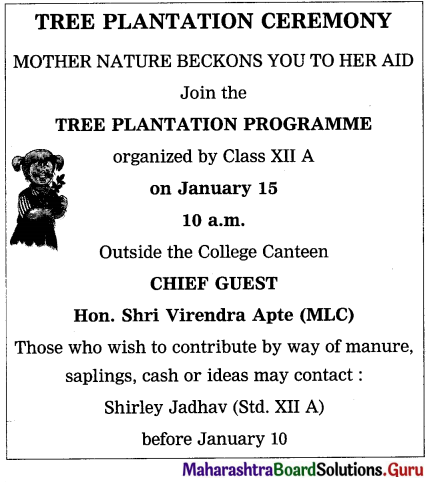

Question 2.
Prepare a leaflet on ‘Save the Earth’. Make use of the foUowing points:
– make the slogan attractive
– make a persuasive appeal
– give information about the programmes to be undertaken
– ask for contributions
– explain the need to save the environment
– add other ideas of your own
Answer:

Question 2.
Prepare a short tourist leaflet on any seaside resort you have visited with the help of points given below :
1. How to reach there?
2. Accommodation.
3. Places worth-seeing.
4. Specialities.
5. Add your own points.
Answer:
Devbagh
Devbagh, a seaside resort, is a tiny island off the west coast of Karwar, in Karnataka. It is near the confluence of the Kali river and the sea.
- Ways to reach: Devbagh is well- connected to Mumbai and Bengaluru by road. It is 2 hours by road from Goa and a 20-minute boat ride from Karwar.
- Accommodation available : Devbagh forest beach resort offers cozily furnished tents and log cabins.
- Sight-seeing : Shivganga Falls, Magod Falls, Lalguli Falls, Dandeli Wildlife Sanctuary, Temples, Historical spots, Beautiful beaches, etc.
- Specialities : Spicy crab curry is the region’s speciality. Most food preparations are liberally garnished with coconut.
- Most suitable time for visits : Throughout the year, though the best season is from October to May.
- Additional information: Plenty of interesting activities for the adventurous – water sports, cruises to neighbouring uninhabited islands, snorkelling trips, sea kayaking, rafting trips, etc.

Appeal
Write the following appeals as instructed:
Question 1.
A student in your college seeks immediate medical help. His parents are unable to afford the huge amount needed for the operation. Prepare an appeal to be put on the college noticeboard requesting the students to donate generously. Take the help of the following points:
– the name of the illness
– the cost of the operation
– how the contributions can be made
Answer:

Question 2.
Prepare an appeal based on the information given below:
The Khadi and Village Industries Commission proposes to promote Khadi wear. They would like people to buy and wear Khadi for natural feel and elegant texture. The cloth also promotes good health and ensures quality. They propose to give a special discount on cotton, silk (spun), silk (reeled), woollen and polyvastra varieties of Khadi. Every metre of Khadi purchased by each of you will help provide employment to many.
Answer:

Interview
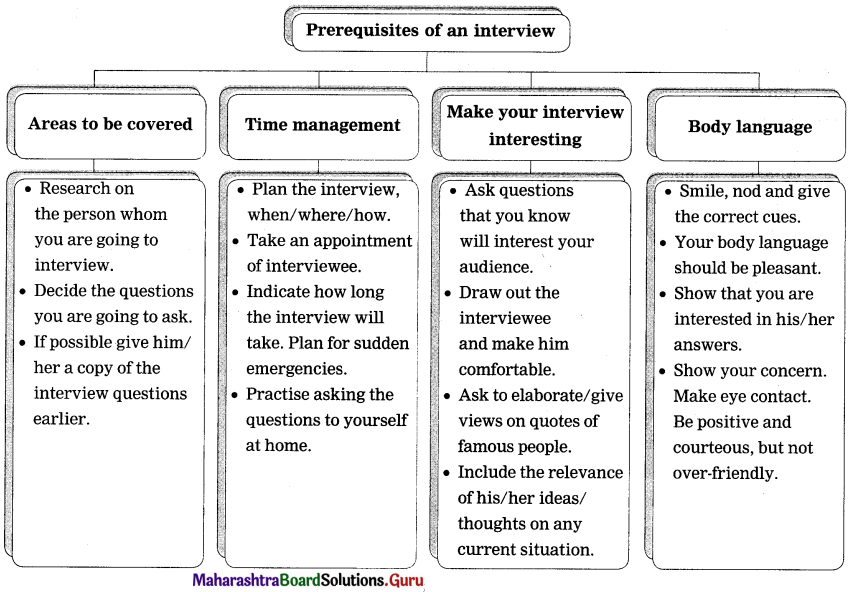

Write interview questions based on the given situation:
Question 1.
Imagine that you have to interview a social campaigner of your choice. Frame a set of 8-10 questions to interview him/ her as per the following points :
- Introducing the guest
- Background of the campaign
- Setbacks/Criticism
- Support/Achievements
- Dreams/Message
Answer:
Good morning, Ms. Nandita Das! Glad to have you on our show. Your ‘Black is Beautiful’ campaign has been a great success and I think our viewers would like to know something more about it.
- Let me begin by asking you the most relevant question first: What had prompted you to take up such a radical campaign?
- What were the initial setbacks that you had faced?
- Were you apprehensive of the reaction from traditional society?
- How do you explain our deep-rooted obsession with skin colour?
- Has the Western World changed their attitude of “White supremacy” over the years?
- Does this “colour bias” affect the boys as much as the girls?
- Who supported you most during the campaign?
- Certain print media groups and television channels stopped accepting advertisements for the so called ‘fairness creams’ after your campaign. Do you expect many more such positive initiatives?
- Many people, especially young girls, look up to you as their idol. How do you hope to live up to their expectations?
- Is there any special message for our youth?
Question 2.
Imagine that yon have to interview the District Medical Officer during the outbreak of a serious epidemic. Frame a set of 8-10 questions to interview him/her as per the following points:
- introduction
- the gravity of the situation
- briefing on technical terms
- importance of precautions
- preparedness to combat the disease
Answer:
Today we have with us our DMO to reassure us about the safety measures taken by the district authorities. Good morning Madam! Could you spare a few moments to enlighten our viewers about the unprecedented situation we face now.
- Thank you. Let me first ask you how grave is the situation as of now?
- There are many new term in currency now as quarantine, self-isolation, tracing contacts, etc. Could you briefly explain these terms for the benefit of our general viewers?
- How important is social-distancing in the present scenario?
- Should masks to be preserved for the frontline workers or is it a must for each and everyone?
- Do we have enough testing kits now?
- What is the difference between rapid test and RT-PCR test?
- What are the elementary precaution to be taken other than social-distancing and hand- hygiene?
- Do you have enough medical staff to tide over such an emergency?
- Do we have enough ventilators and ICU beds?
- How is the coordination between the various departments of the district administration?

Question 3.
Imagine that you have to interview a “Save the Trees” campaigner. Frame a set of 8-10 questions to interview him/her as per the following points:
- introduction
- success so far
- forest conservation laws
- attitude of people to climate change
- factors working for and against the campaign
Answer:
Good evening Sir! I think it is the need of the time that our young generation realize the importance of your campaign. I am very glad to have you on our special “Environment Day” programme.
- How do you evaluate the success of your campaign so far?
- Do you think that people still show a callous disregard towards the threat of climate change?
- Why is there a lack of awareness among our countrymen about the importance of trees?
- Why doesn’t the government enforce the forest conservation laws effectively?
- What are the substitutes for timber in the construction industry?
- Have you ever felt that you are defending a lost cause?
- How far does the Indian tradition of worshipping trees help you in your campaign?
- Do you get enough funds to carry on your campaign?
- Is the younger generation more receptive to environmental issues?
- What piece of advice would you like to give to the school children?
Question 4.
Imagine that you have to interview a teacher who has received the President’s award. Prepare a set of 8-10 questions to interview him/her as per the following points:
- Introducing the guest
- Feeling during the moment
- Reason for taking up teaching
- Contentment/Satisfaction
- Opinion about young teachers
- Setback and reward of the profession
Answer:
Good morning Madam! I take it as a great privilege to be with you and have a chat. Thank you very much for sparing your valuable time.
- How did you feel during those brief moments with the President?
- Do you think that you have lived a complete life and it is time to retire?
- At what point of time in your life did you find that teaching is your calling?
- Many teachers find teaching a thankless job : What is your opinion about that?
- Was there any conflict between your personal life and professional life?
- Do you think teaching attracts real talent in this materialistic world?
- What, in your view, are the most essential qualities of a teacher?
- Do you find the young cro0p of teachers as great promise?
- What were the setbacks that you faced in your long career?
- How did your students, who are spread far and wide, react to this honour?

E-Mails:
Question 1.
Read the following advertisement and prepare a letter of application to be sent by email. (Do not give your bio-data.)
Situation Vacant
Wanted: A Computer Engineer
Candidate must have passed B.E. in
Computer Engineering.
Experience holder will be preferred.
Write giving details to:
Email: armancon@gmail.com
Sir/Madam,I have recently passed my B.E. in Computer Engineering from J L M Engineering College, Ratnagiri with a pass percentage of 61.1 also have three months of experience developing software for Pragati Electronics in Ratnagiri. The project was for the maintenance of accounts of MHEL Pvt. Ltd.
I do hope that you will consider me for appointment in your esteemed company. I shall be able to arrange my own accommodation in Pune. I anticipate an early call for an interview. My details are in the CV that I have attached.
I assure you of dedicated service, should I be considered for the post.
Yours truly,
XYZ
Blog Writing
A List of Blogging Sites/Apps.
Given below is a list of blogging sites/ apps from where you can begin blogging.
1. https://zapier.com/blog/best-blog-sites/
2. https://www.wpbeginner.com/beginners- guide/how-to-clioose-the-best-blogging- platform/
3. https: / /www. say ansamanta. com/best- android-apps-blogger.html
4. https://www.excellentwebworld.com/latest- blogging-trend/
5. https://www.livejournal.com
6. https:// www.wordpress.com
7. https://www.blogger.com
8. https://www.blogs.myspace.com.

Question 1.
Write blogs on the following topics
Say no to tobacco.
Answer:

Question 2.
Man v/s Nature.
Answer:
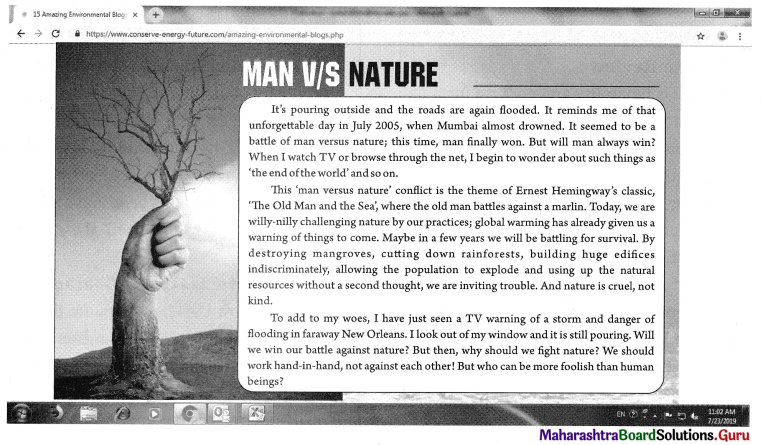
Film Review:
Students are advised to read film reviews that appear in periodicals and online. This will familiarize them with the technical terms and expressions used in reviews.
After viewing a film, attempt to write your own review based on the guidelines given above. It is always a good practice to make a first draft and revise it after some time. This will help you eliminate any personal bias that has distorted the review. Revising the text also enables you to write comprehensive but concise reviews.

The Art of Compering
Imagine that you are a compere of the ‘Annual Day Celebrations’ of your college. Write a script for the same. You can take the help of the following points.
- Brief introduction
- Lighting of the Lamp
- Welcome Speech
- Speech of the Chief Guest
- Entertainments
- Vote of thanks
Answer:
1. Introduction and lighting the lamp: Good evening to all present here today on this special occasion. We have been awaiting this day with great anticipation. And finally here we are gathered to usher in that great day! Let’s begin the function with the lighting of the traditional lamp and I request our honourable Chief Guest Shri Ganesh Narvekar to inaugurate the function by lighting the lamp. [The chief guest together with certain other dignitaries on the dais lit the lamp.]
2. Welcome speech: Next we go to the Welcome Speech. Our respected Principal will now address the audience and welcome the Chief Guest. [Principal’s speech – 8-10 minutes.]
3. Speech of the Chief Guest: Now I request the honourable Chief Guest to take the podium.
[Chief Guest comes to the podium and delivers his speech – about 10 minutes.]
4. Entertainments: Now the curtains will be down for a few moments in preparation for the entertainment programme.
[Curtains down. The chief guest and other dignitaries are ushered to their seats in the audience. Stage is cleared. Curtain raises.]
(a) Now the college orchestra will delight you with their musical programme.
/Musical programme for 45 minutes]
(b) Yes, that was a big round of applause and a greatly deserved one! Let’s move on to our next item. Students of Std. XI will now perform a fusion dance. Welcome them with a warm applause!
[Dance lasts about 30 minutes.]
5. Vote of thanks: Now I call upon our Vice-principal to propose a vote of thanks. [About 2-3 minutes]
Now I thank you all once again. Special thanks to our talented artist-friends who made this evening a memorable one.
![]()
![]()
![]()
![]()














